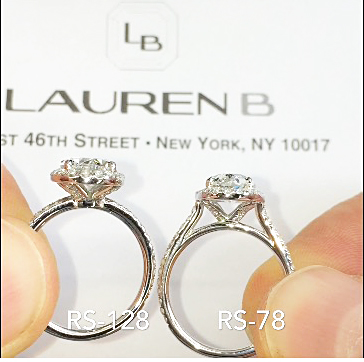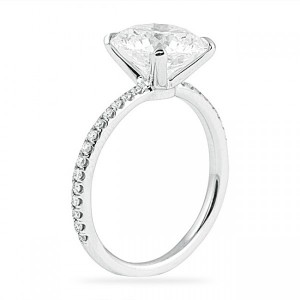There are two major types of engagement ring band styles to consider when selecting your engagement ring. The arching cathedral design versus what we like to call the floating style. Both of these styles have their own unique attributes that make them desirable for certain people’s tastes. At Lauren B we offer full custom engagement rings where our clients can select each aspect of the ring so it is important to consider all the details. Today we will look at Cathedral vs Non-Cathedral Engagement rings. Here we will try to break this particular design aspect down so you can select the one that would be perfect for you.
 CATHEDRAL STYLE
CATHEDRAL STYLE
.rings feature a band that slopes up to around the same level as the girdle or edge of the center diamond. Remember this ONLY refers to the the sloping of the band. It can be incorporated in an array of different custom engagement ring designs such as the popular round solitaire pave RS-205 (shown to the right) or a more complex halo design such as model RS-213 custom round in cushion halo design. The cathedral design can have single r triple micropave to channel settings and even plain ones. Also, contrary to popular belief a cathedral style band does not mean that the center diamond has to be set up high and is just a matter of craftsmanship and precision. The culet, or bottom tip, of the diamond can be at the same level whether it is cathedral style or non so do not steer clear of this style if you think the ring will be sitting “too high” off of your finger.
 Pros: Cathedral style engagement rings have a certain elegance to them that is a result of the extra detail you can incorporate into the gallery/underside of the center diamond. With more room to work with you are able to include additional pave diamonds or metal work to the ring to give it some extra flair and appeal (see oval engagement ring to the left). Generally speaking, the natural curving nature of this ring can also give the ring a more structured, solid feel and look to it which can be appealing to some.
Pros: Cathedral style engagement rings have a certain elegance to them that is a result of the extra detail you can incorporate into the gallery/underside of the center diamond. With more room to work with you are able to include additional pave diamonds or metal work to the ring to give it some extra flair and appeal (see oval engagement ring to the left). Generally speaking, the natural curving nature of this ring can also give the ring a more structured, solid feel and look to it which can be appealing to some.
Cons: Some prefer more streamlined look and feel that the additional design features can compete with center diamond. Because the band curves up to the edge of the center diamond it may impede the view from the profile and also create a more cluttered look in some people’s eyes. For those who want the focus of the ring to be strictly on the center diamond perhaps this style should not be a consideratio
 RESTING ON TOP/FLOATING LOOK:
RESTING ON TOP/FLOATING LOOK:
While there is no particular word to coin this style, it refers to a ring where the prongs holding the center diamond, or stems coming from the halo, attach to the band at one single point. The band comes from the bottom of the finger and tucks under the center piece, as opposed to sloping up towards it, thus creating a floating look where the center diamond/piece is almost suspended in thin air. As with the cathedral style, this floating look can be done with halos and solitaires and any style of diamond band. They can also be done with any type of band from thicker pave or three-row micropave and plain ones. For the most elegant, simple of floating style rings please see RS-198 to the left from our website
Pros: This puts the emphasis of the ring squarely on the center piece whether it be a halo style or a simple four prong top. The major draw, and reason for its extreme popularity of late, is that it can make the center diamond look even larger. Many people prefer to use a very delicate band which can accentuate the sparkle and beauty of the center diamond even more. Also, this style can be made to sit especially flush to the finger for those who prefer an ultra low profile setting.
Cons: It is hard to find any fault with this ring design but some may say it looks and feels too delicate for them and prefer a ring with a bit more structure to it. Also because of the more streamlined look there is less room to add detail within the gallery. We have, however, managed to implement a great touch of detail to this style with a pave scarf that wraps underneath the stone as shown in our popular RS-63 design to the right.



